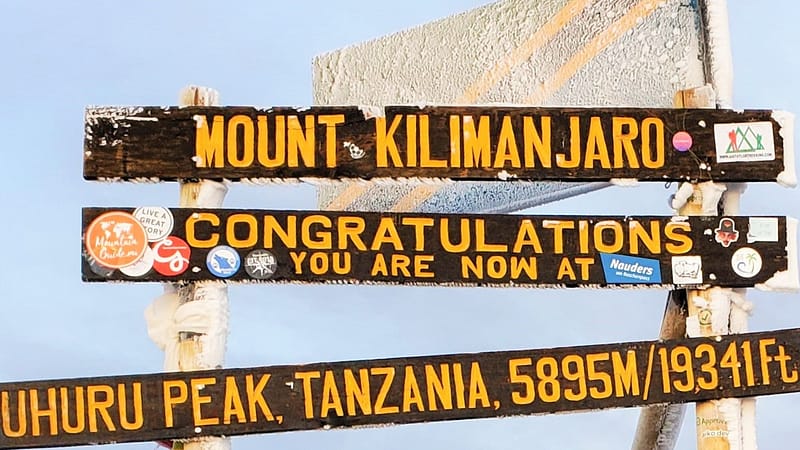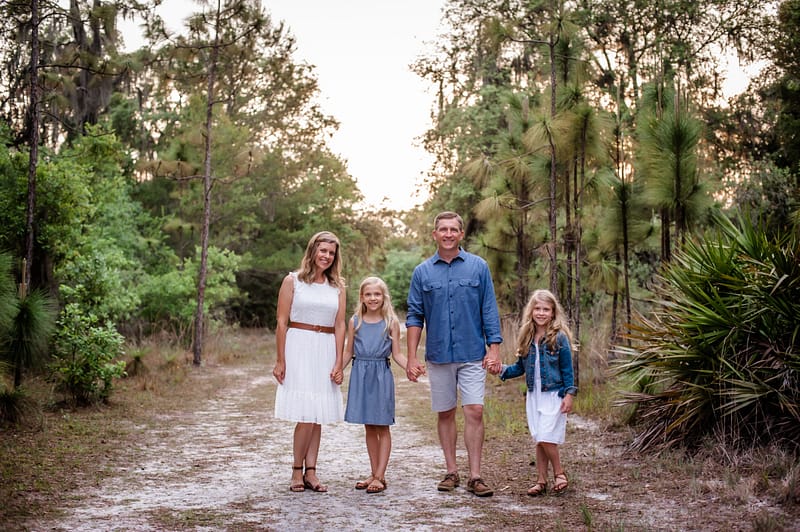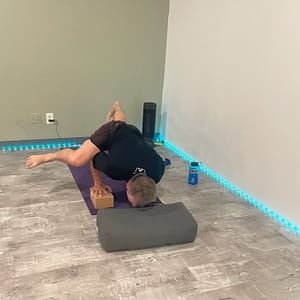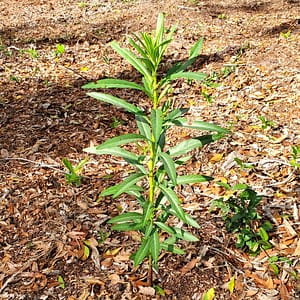Were you able to guess where Kim and I were on our Type 2 Fun adventure? This picture should sum it up.
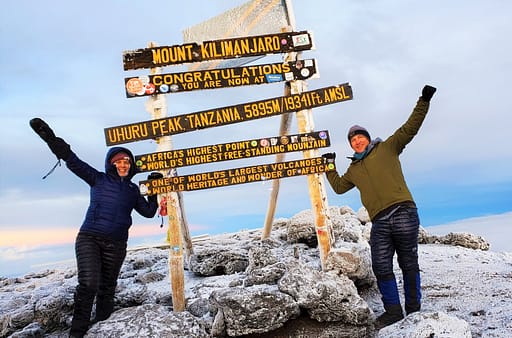
I’ve been trying to decide how to write about our trip. It was amazing, tremendous, memorable, for us a huge accomplishment and the culmination of years and years of dreaming. It’s hard to put the experience into words. But I thought I might try to capture the toughest part of the trip: Summit Night.
First, a little background. Kilimanjaro is the highest peak on the African continent and one of the Seven Summits: the group of mountains that are the highest peaks on each continent. (They are Everest, Denali, Aconcagua, Carstensz Pyramid, Elbrus, Vinson, and Kilimanjaro). While Kilimanjaro is considered the most attainable of the seven summits and doesn’t require any technical alpine mountaineering skills, it is still a challenging climb and often underestimated. At 19,341 feet, the oxygen levels at the top are 50% what they are here at sea level.
The climb that we did was an 8-day expedition: 6 days to the top, 2 days down. We chose this route (the Lemosho Route) because the slower you go up, the better your body adjusts to less oxygen and the better chance you have of making it to the summit. Each of the days leading up to summit night was definitely a challenging hike, but Kim and I had done plenty of training ahead of time and were in pretty good shape.
Summit night was a whole different animal. On that day, we started in the morning by climbing up to our high camp at 15,300 feet. Then we had lunch at our camp and were given time to pack and rest in preparation for our summit bid. You would think that the best way to get ready to climb to the top of the mountain would mean a good night’s sleep. Not the case. First, we were excited and nervous about the upcoming climb. Second, the wind was howling across the campsite. And third, we were going to be woken up at 10:30 p.m. anyhow. Definitely hard to sleep. So at 10:30 p.m. sharp, our guides woke us up. At 11 p.m. we had “breakfast,” and at midnight we were bundled up in all of our layers, headlamps on, ready to head to the summit.
This night and day of hiking and climbing were definitely among the hardest things physically and mentally that we’ve ever done. In Swahili, the saying on the mountain is “Pole Pole” which translates to “Slowly, Slowly.” And “pole pole” we went. Tanzanian guide Auguste was in the lead, and one foot after another he set our pace up the mountain. One breath. One step. Staring at the back of the climber in front of you, wondering when the next break was. It was quite a trudge. And it lasted for 6 hours. We took a break about every hour, but it was so cold and windy that they didn’t last long. So cold in fact that our water froze in our backpacks, even though our bottles were wrapped in down parkas! At each break we’d wrestle our thick overmitts off, grab an energy gel, drink some slushy ice water, and then it was time to trudge again. We’d have energy for about 30 minutes, and then that boost of sugar would fade and we had to find something to keep our minds occupied. Kim sang “Hamilton,” I reviewed every 90s grunge rock song I could remember.
And then finally around 5 in the morning we reached Stella Point. Not the summit, but a point about an hour away. Our guides had brought some hot water, so we had a quick hot drink and could just start to see the sun peeking at the horizon. From there we had less uphill climbing and more of a walk around the crater to get to the actual summit.
It couldn’t have been timed more perfectly. We reached the summit (Uhuru Peak) to the most gorgeous sunrise I’ve ever seen. Across the snow-kissed rocks and glaciers a gorgeous orange and pink sky revealed itself. But as famous mountaineer Ed Viesturs once said, “Getting to the top is optional. Getting down is mandatory.”
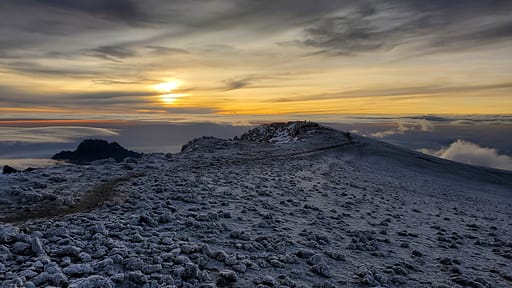
We only spent 15 minutes at the summit, which seems kind of crazy given how long it took to get there, but with low oxygen it just isn’t somewhere you stay for a long time. We accomplished a lot in 15 minutes. We took lots of pics, enjoyed the sunrise, renewed our wedding vows (it was our 18th anniversary on summit night), and basked in the feeling of accomplishment of having made it to the top.

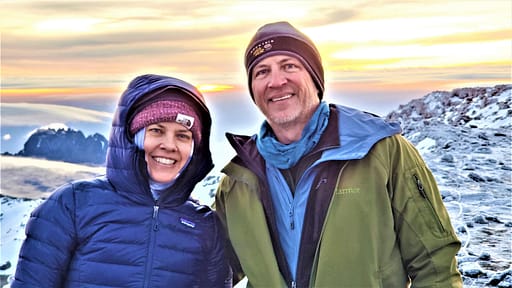
Then it was time to start down. In just 2½ hours, we made it all the way back to our high camp where you would think we’d take a nap and recover a little. Nope. We packed up our tent, repacked our backpacks, ate lunch, started to rehydrate a little, and then continued on down the mountain. Our destination was a camp another 5000 vertical feet below us. And it turned out this was definitely the hardest part of our climb. Not going up, coming down. While each step gave us more oxygen to breathe, each step was also punishing on our knees. The last few miles were on these craggy stone steps that jolted our legs unceasingly. Our guide kept saying, “Almost there,” around every turn, but he was fibbing. When we finally stumbled into camp it was with great relief. We took off our backpacks, soaked our feet in warm water, and laid down for a little bit. Standing back up was a challenge, and our legs ached for a few days. There just isn’t a good way to train for downhill hiking, especially here in Florida.
But we made it. Up and down again. It was an amazing trip. We had an awesome guide, met some incredible Tanzanian people (our summit leader Auguste has been to the top of Kili 500 times!), and also had a great group of climbers with us that made the trip memorable. This is a trip we will never forget. Even just a few weeks later, we are already missing the adventure and beauty of Kilimanjaro. As John Muir once said, “The mountains are calling and I must go.” Who knows where our mountain dreams will take us next?

But that’s enough dreaming about past and future adventures. Here and now, it is one of the most wonderful times of the year. It’s veggie season! Veggie starts have arrived as well as a complete set of seeds to get your spring vegetable garden started. And lots of you have registered for this Saturday’s veggie seminar. If you haven’t yet, don’t worry, registration isn’t required, just come out at 10 a.m. this Saturday, February 18, and I’ll teach you all about growing veggies in Florida. Spring is here, and it’s going to be a wonderful one.

